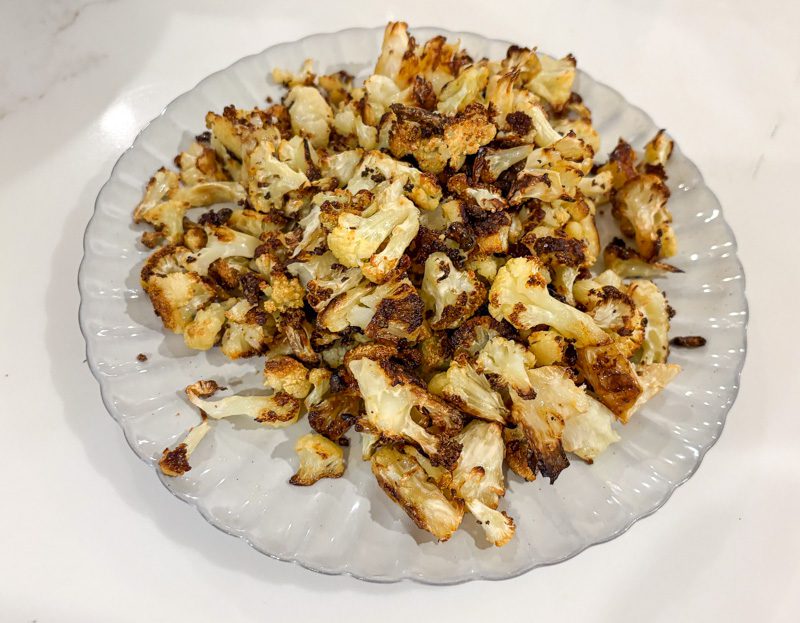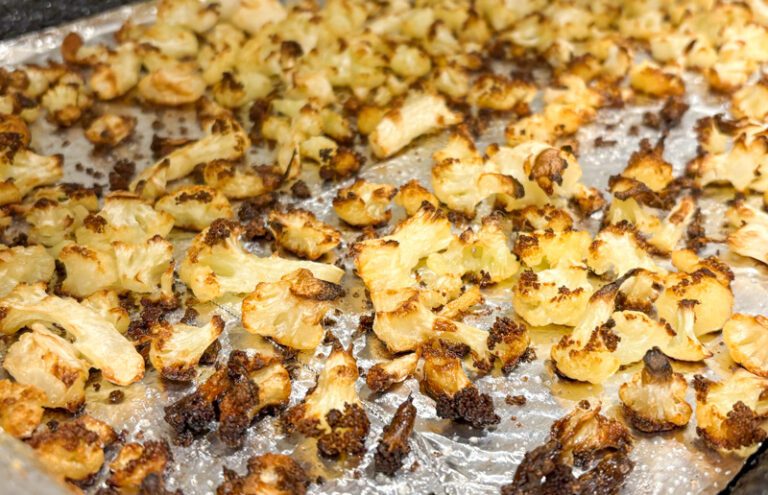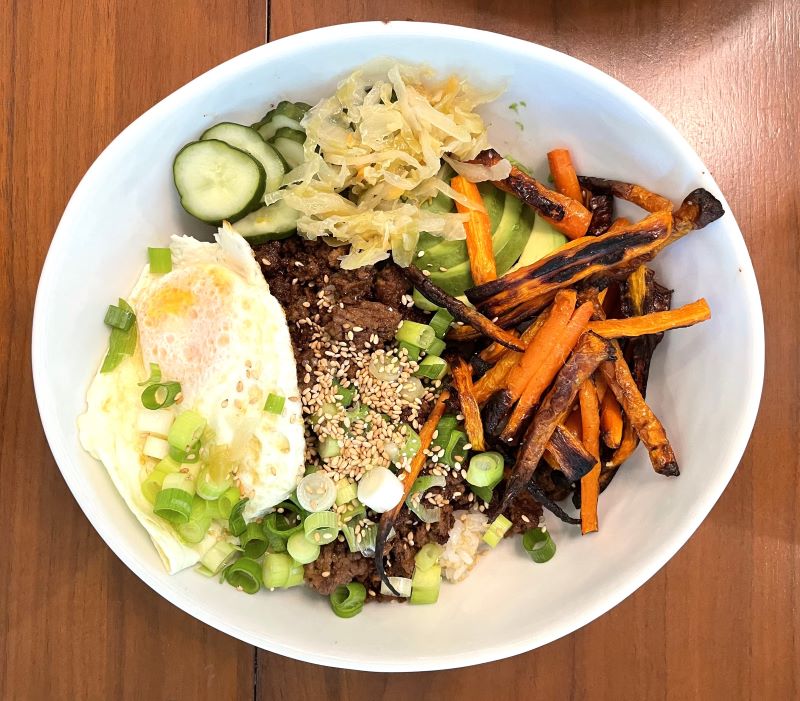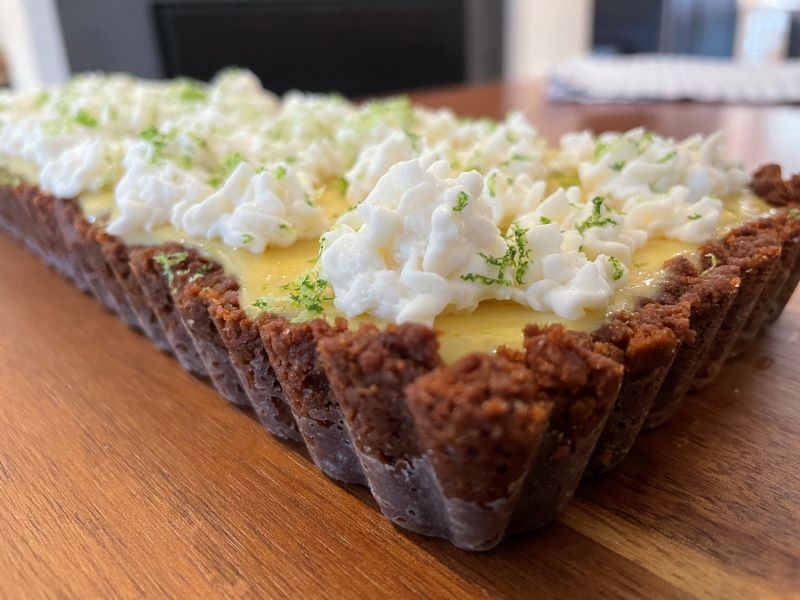The only thing faster than making this healthy popcorn cauliflower is how quickly our kids eat it . . .

Family-Friendly Food
My middle child is all about protein. He loves his chicken, beef, salmon, etc. But he is very difficult to coax into eating vegetables, and difficult about trying anything new. This makes feeding him a new vegetable a next-level challenge. We have a few old reliables (sweet potato pancakes, vegetable muffins), but new foods are always a bit of a challenge.
This “popcorn cauliflower” has bucked that trend, so I’m sharing it here. It’s also incredibly easy to make. We make this about 1-2 times a week these days. We call it popcorn cauliflower because (1) it’s addictive, and (2) I let our kids eat it with their hands, like popcorn. It’s way more fun to eat that way – and it results in them eating a lot of it.
This is also great for our 1 year old, who only has 4 teeth and is still transitioning to solid foods. The cauliflower is crispy but it also sort of melts in your mouth.
A Psychological Approach to Food Introductions
Okay, so this is definitely not the best manners – but this is how I got my son to eat this cauliflower popcorn and realize he loves it. Taking a leaf from French Kids Eat Everything, I offered the food to him in a low-pressure environment. In French Kids Eat Everything, Le Billon suggests that the time right before dinner, when the family gathers away from the table is actually a great, low-stakes environment to offer a kid new foods. Our family doesn’t gather ahead of dinner to talk like French families apparently do. Our house is more of a beg for our kids’ attention and eventually coerce them over to the kitchen table situation come dinner time.
Keeping it Low-Pressure
But one evening my son was playing in the next room, and I pulled this cauliflower out of the oven. I let it cool for a minute, and (as usual) I snuck a little bite. Then I thought, why not let him try as well. So I asked him if he wanted to come in and try something with me before everyone else came in. I used my fingers to nab a couple bites of cauliflower straight off of the tray and devoured it in front of him. Then I offered him the tray, and he grabbed some and ate away. He loved it!
One great thing about this setup was that I wasn’t going to be too frustrated if he declined. We hadn’t sat down for dinner yet, so it didn’t really matter to me whether or not he ate the food. And I think the spontaneity of it, the slight thrill of sneaking food before everyone joined us in the kitchen, and his being hungry because it was dinner time, got him interested in eating it. I saw how it was working, so I kept taking little bites – and then he started to get competitive, eating it as fast as he could! We pretty much finished the entire tray before the rest of the family came in. Good thing I had another vegetable that evening! But I was so happy for him.

Embracing a Scarcity Mindset
So this leads into my next suggestion. Serve the cauliflower to the kids right on the baking sheet!
For whatever reason, our kids never eat the cauliflower as well as when the tray is set up between the two older kids, and they see that the other one is grabbing little bites of cauliflower. They are absolutely desperate to get as much as they can before the other (or the parents) take more. It’s a competition. A classic “tragedy of the commons” situation – except no tragedy here, just happy parents and fibered-up kids.
I’ve tried to make this a more civil situation by serving them the same exact cauliflower on their plates. Our kids will eat some cauliflower on these occasions – but not as much. They have to be asked. There is 0 frenzy. I think because they know their stash is protected because its on the plate (more on this below).
There is of course a middle ground where you give them a bit on the plate, and then put the tray in front of them so they can see how much is remaining. You tell them they can’t get more until they’ve finished what is on their plates. But even this – there is something about them knowing they at least have the amount on the plate that diminishes the frenzy.
So if you can tolerate the poor manners – I’ve found it so worth it to just plop down the tray and let our kids feast like wild dogs. Ideally before the rest of the food comes out, so they are very hungry.
Economic Theories Around the Table
I touched on this above, but from my experiences with my kids, you may have guessed that I’ve developed a working theory. Make the vegetables community property. Privatize the desserts.
Vegetables
If this is a shared but at least somewhat appealing resource, in our family, you get a classic tragedy of the commons situation, where kids rush to take their portion before others can. This is particularly helpful when they are very hungry (i.e., at the start of dinner). I therefore like to serve a bowl or plate of vegetables for the table to share. I keep it directly in front of the children so that they can see how rapidly it is diminishing. If the kids don’t get in there right away – I will get in there, adding the pressure by making it visibly diminish by eating it myself.
Dessert
If the kids feel individual ownership of their dessert portion, they will be more protective of it and eat it more slowly. For this reason, I usually serve desserts pre-portioned. This encourages our kids to savor the food, sometimes even eating less, to stretch out the private resource. It also sets expectations about what the total dessert portion will be (our kids rarely ask for more dessert, but when they do, they accept a no fairly quickly). When kids are older, I’ve heard of families designating a tub of ice cream for each child, setting a refill date when they can get another tub of ice cream. Parents leave it up to the kid to decide how much ice cream to eat day-to-day, but he can only tap his own tub. Remarkably, many kids end up rationing or hoarding their tubs – not finishing the tub by the next ice cream purchase date!
Now enough on that topic, let’s get back to cauliflower.
Health Benefits of Popcorn Cauliflower
Fiber, fiber, fiber. Cauliflower has lots of dietary fiber. This helps with satiety and stabilizing blood sugar levels. It’s also low calorie and low carbohydrate, if you’re into that sort of thing.
It also has vitamin C, vitamin K, vitamin B6, and folate. Good source of potassium, and has a bit of magnesium. Trace amounts of iron.
In short, cauliflower is in fact very healthy! Do I have any other shocking news to share?
No. Let’s do the recipe now.
Print
Popcorn Cauliflower
This is a very simple recipe for crispy-crunchy cauliflower. Roasting it this way brings out a slight sweetness, and dusting it with salt before baking adds an addictive salty note. This is why we call it popcorn cauliflower. It’s hard not to eat it all with your bare hands before everyone sits down to dinner. Our kids are big fans.
It has only three ingredients: cauliflower, olive oil, and salt.
- Total Time: 30 min
- Yield: 4 servings 1x
Ingredients
20 oz cauliflower florets (give or take)
3–4 tbsp olive oil
salt
Instructions
1. Preheat oven to 425F.
2. Prepare cauliflower to bake.
Take a sheet pan and line it with aluminum foil. This will significantly simplify your cleanup.
Dump the cauliflower onto the foil.
Using your fingers, break apart the cauliflower into small pieces. You want some tiny pieces, some small pieces, and some small-medium pieces. Nothing too large, because it won’t crisp up as well and will get a bit mushy. Once everything is broken up, spread it out evenly across the sheet in one layer. If you have too much cauliflower to spread in an even layer, use another sheet. Having one layer is critical to get the crispy crunchy effect.
It should look like this:
Next, spray it down with 3-4 tbsp of olive oil so that it is very well coated. I use a spray bottle like this to do this part. (If you spray it, you don’t need to toss it in the olive oil – spraying is enough.)
If you don’t have a spray bottle, drizzle olive oil all over the cauliflower, and then toss it in the olive oil, then spread the cauliflower back out in an even layer across the sheet.
Sprinkle everything down with some salt. Salt is key.
3. Roast the cauliflower for 20-25 minutes.
If you have convection, use the convection setting to speed up the process a bit and increase crispness.
The cauliflower is ready when it has browned. Some of the small bits will look a dark brown – these are the crispy crunchy parts that make it very tasty. Just try to avoid getting anything past a dark brown shade, or you’re going to be eating some burnt stuff. See below for our ideal cauliflower situation:

4. Let the cauliflower rest on the baking sheet for 5-10 minutes before serving.
If you remove the cauliflower from the sheet and pile it onto a plate before it cools a bit, it will steam itself so that the crispy parts lose their crispy crunchy texture and turn into mush. So don’t skip the rest period! If you need to eat right away, eat it off of the sheet pan. I’m serious!
5. Enjoy!
- Prep Time: 5 min
- Cook Time: 25 min
- Category: Side
- Method: Bake



